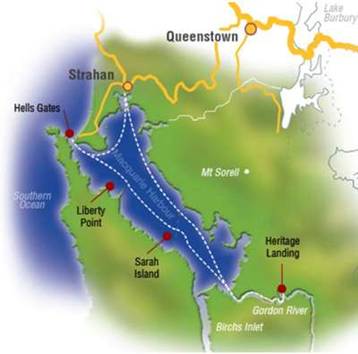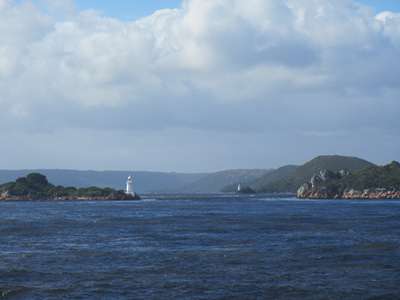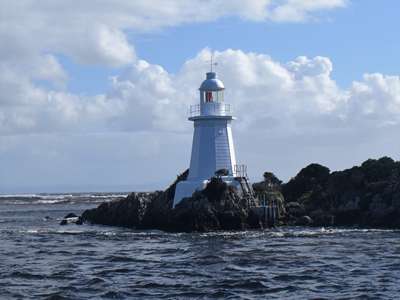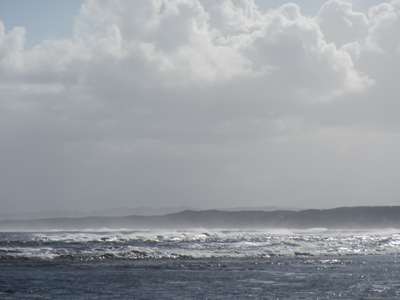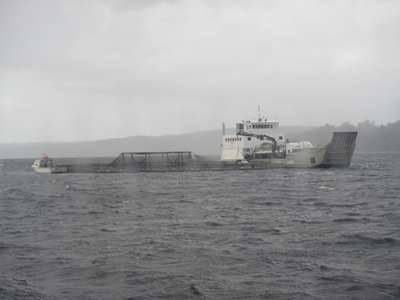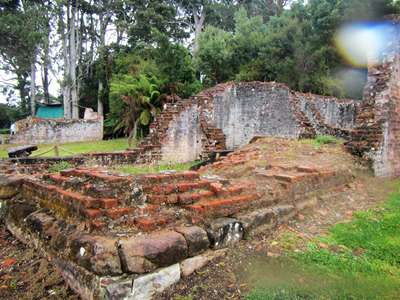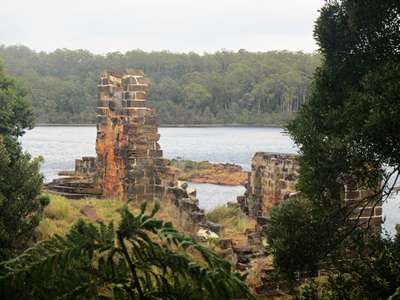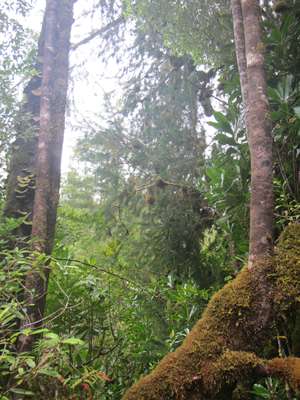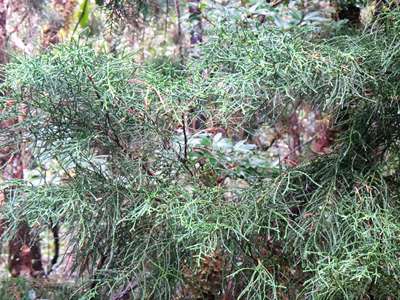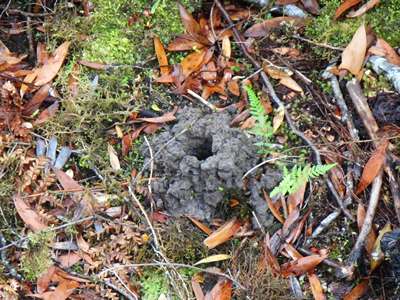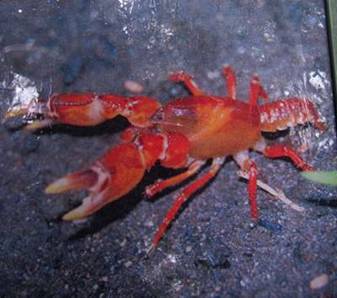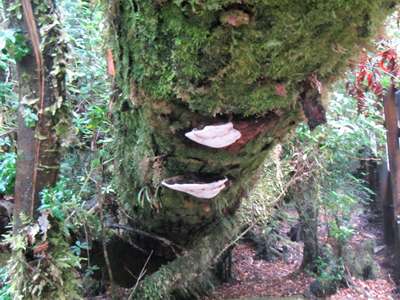Gordon River Cruise

|
Tuesday 16th February 2016 Today’s trip took us back onto the water. This
time it was on a power catamaran that was capable of covering the mileage out
of Strahan to Hell’s Gate, the entrance to Macquarie Harbour, then across
the harbour to Sarah Island, one of the first convict settlements in Van
Dieman’s Land, on to Heritage Landing in the Gordon River, and finally
back across Macquarie Harbour to Strahan, all in a day.
Today’s route. We settled back in our window seats and enjoyed being
passengers instead of crew and travelling at 20+ knots instead of 6. Our
first stop was not really a stop, but a drive through Hell’s Gate, turn
around and drive back in again. This suited me fine – one glance at
the Southern Ocean outside confirmed I didn’t need to go any further! The narrow entrance to the huge
Macquarie Harbour is just 120 metres wide and was discovered in 1815. It
is said that its name, ‘Hell’s Gate’ was given to it by convicts
passing through on their way to Sarah Island Penal Colony, as a reflection of
the conditions they would soon endure on the island. An alternative
theory, however, is that the name describes the water at the entrance, which is
shallow and strewn with rocks which causes the water to boil and swirl with
eddies and undercurrents. The land surrounding Macquarie
Harbour was rich in Huon pine, and it was not long after the discovery of the
entrance to the harbour that timber was being cut and shipped out through
Hell’s Gate. In the 1890's the discovery of silver and lead at
Zeehan greatly increased the traffic entering the harbour and works were taken
to improve the entrance. In 1891, a light was exhibited from two white six-sided
wooden towers, one on the western side of Entrance Island, and the other on
Bonnet Island. A breakwater was also constructed at Hells Gate to check the
sandbar.
The two lighthouses marking the 120 metre-wide channel at
Hell’s Gate.
Outside Hell’s Gate – in Kelly’s
Channel by the breakwater. Going
back in, still not smooth till out of the channel. This is likely to be the only time we are on a boat in the
Southern Ocean. Once back in Macquarie Harbour, we made for Sarah Island,
passing a fish farm on the way at Liberty Point, where Aquaculture pens are stocked with thousands of Atlantic
salmon and ocean trout.
The fishing boat sucks water from the pens up a tube,
bringing the fish with it, filters them out and returns the water to the
harbour. Then it was on to Sarah Island where we were given a guided
tour and then an opportunity to stroll and explore. Sarah Island was
viewed as a suitable place to build a penal colony for some of the worst
offenders, because of its remote location, and because the convicts could be
used as cheap labour for timber-felling. The first brig arrived in 1822,
the first having had to turn back to Hobart because of bad weather, with 66
male and 8 female convicts on board. The ground was cleared and shelters erected, and gradually a
settlement took shape. A brick gaol was built in 1826, followed by a
bakehouse and penitentiary building two years later. The remains of these
are still on the island. The bricks were made by convicts from local clay
2 km away on the mainland, and the walls of the gaol were built nearly half a
metre thick!
Brick remains of the gaol on Sarah Island. This
is believed to have been the penitentiary. As well as
brickmaking, industries including ship building, tanning and shoe-making were
developed. Shipbuilding became the biggest and most successful of these,
with 131 vessels being built out of the locally felled Huon pine in 12 years in
the biggest shipyard in the colonies at the time. Continuing problems of access
and security, however, plus the opening of the Port Arthur penal settlement in
1830 led to the closure of Macquarie Harbour Penal Colony on Sarah Island in
1833. Our next stop was
Heritage Landing in the Gordon River, and as we left the harbour and entered
the river the boat slowed to keep the wash to a minimum and reduce damage to
the flora and fauna on the banks. We went some way up the river, and on
both sides were dense forests. We disembarked at the landing and followed
the boardwalk into the forest. The welcome board told us that this cool,
temperate rainforest is part of the Tasmanian Wilderness World Heritage Area,
protected for all time and for everyone and includes trees such as Sassafras,
Myrtle Beech and Huon Pine, some of which are almost 2000 years old.
The boardwalk led us through thick rainforest. Foliage
of the Huon pine tree, which grows only 1 millimetre per year.
We wondered what had made these mud ‘chimneys’.
An info board told us they are made by burrowing crayfish found only in
Tasmania. They are part of a maze of underground chambers made to
store water.
The wet and humid conditions are good for the growth of
tree fungi. Over 3 metres of rain fall here annually. By now we were thoroughly wet, and it was nice to retreat to
the warm and dry boat and settle back in our seats with a hot drink for the trip
back to Strahan. Once out of the Gordon River we picked up speed again,
and within an hour we were back at Strahan wharf. We stepped off the boat
next to Morrison’s sawmill where a Huon pine log was being sawn.
What a wonderful smell! The felling of live Huon pine trees was stopped in the 1960’s
and they are now protected, but there is a stockpile of trees which were felled
in the past before the land they occupied was flooded by the hydro-electric companies.
Because the timber does not rot, they can be used for decades after they were
cut. It is estimated that there are enough logs stockpiled to last for
the next two human generations. We wandered around enjoying the smell and the feel of the
place. It was an old-fashioned workspace full of old equipment, with
items for sale from rough offcut to intricately carved. We don’t
usually buy souvenirs as there really is not enough room on the boat, but we
persuaded ourselves we could do with a new breadboard, so now we have one of
Huon pine. |
